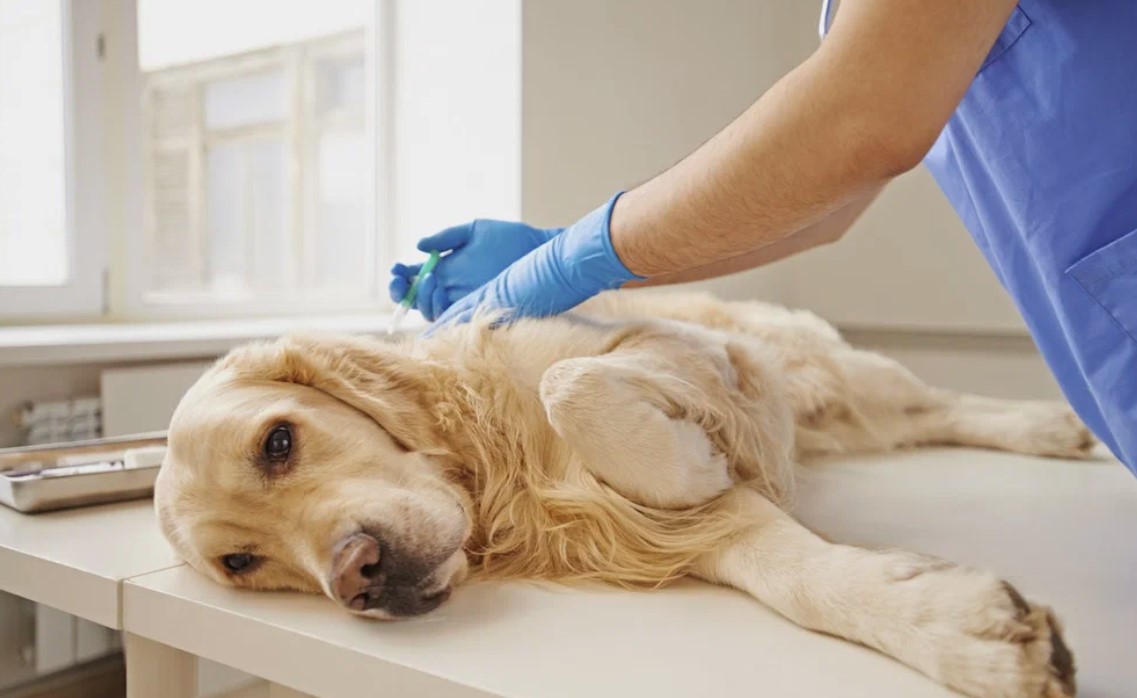Helminths, commonly known as parasitic worms, are a significant concern for animals and humans due to their ability to inhabit various organs and tissues, causing numerous health issues. While these parasites can be found in different parts of the body, the most common form we hear about involves gastrointestinal infections, where worms settle in the intestines. However, in some cases, helminths can migrate to other vital organs, such as the heart, leading to a severe and life-threatening condition known as dirofilariasis, also referred to as heartworm disease.
Heartworm disease, caused by roundworms of the genus Dirofilaria, is particularly dangerous in dogs, where it predominantly affects the cardiovascular system, although it can sometimes manifest in the skin or eyes. Preventative care for pets, including worm treatment for cats, is essential to reduce the risk of such parasitic infections. While heartworms are primarily found in dogs, other animals, including cats, foxes, and even humans, can occasionally contract the disease.
This article delves into the specifics of heartworm disease in dogs, its symptoms, diagnostic methods, treatment options, and most importantly, preventive measures to protect our pets from this dangerous condition.
The Nature of Dirofilariasis and Heartworm Disease
Dirofilariasis is a vector-borne disease transmitted through the bites of blood-sucking insects, primarily mosquitoes. The disease-causing worms belong to the genus Dirofilaria, with the species Dirofilaria immitis being the most common and dangerous type that affects dogs. The transmission process begins when a mosquito bites an infected animal and ingests microfilariae (larvae) from its blood. Once inside the mosquito, these larvae develop over a period of 10-14 days before becoming infective. When the mosquito bites another dog, it transmits these infective larvae, which then enter the bloodstream of the new host.
From there, the microfilariae begin their journey through the bloodstream and settle in the right chambers of the heart, particularly in the right ventricle and atrium, or in the pulmonary arteries. Over time, these larvae mature into adult worms, which can grow up to 12 inches long and live for several years. As the worms multiply, they can cause significant obstruction in the heart and large blood vessels, leading to severe cardiovascular problems.
Forms of Dirofilariasis
Dirofilariasis in dogs can manifest in several forms, depending on where the worms settle in the body. The three most common forms are:
- Cardiac (Heartworm) Form
This is the most dangerous and life-threatening form of the disease. In the cardiac form, adult worms settle in the right side of the heart, particularly the ventricles, atria, and the pulmonary artery, where they can cause extensive damage. This form of the disease can lead to congestive heart failure, blood clots, and even sudden death if left untreated. - Subcutaneous Form
In this form, the worms are localized in the subcutaneous tissues and muscles. Although it is less dangerous than the cardiac form, it causes significant discomfort to the dog. Common symptoms include severe itching, skin inflammation, ulcerations, and redness. This form of the disease is usually not life-threatening but can still lead to secondary infections and chronic skin problems. - Ocular Form
The ocular form of dirofilariasis is extremely rare, but when it occurs, it can lead to inflammatory diseases of the eyes, such as conjunctivitis, keratitis, and even vision loss. This form is generally less common but can cause serious damage to the dog’s eyes if not treated promptly.

Symptoms of Cardiac Dirofilariasis
The symptoms of heartworm disease in dogs are often subtle in the early stages of infection, making it difficult to diagnose without proper veterinary testing. However, as the infection progresses and the number of adult worms increases, the symptoms become more pronounced. The primary symptoms of cardiac dirofilariasis include:
🡪Heart Problems
Dogs with heartworm disease often develop tachycardia (rapid heart rate), arrhythmia (irregular heartbeats), and heart murmurs. These symptoms occur due to the stress placed on the heart by the presence of adult worms, which obstruct blood flow and reduce the heart’s ability to pump efficiently.
🡪Respiratory Distress
Shortness of breath and noisy, labored breathing are common in dogs with heartworm disease. Dogs may exhibit frequent coughing fits, sometimes producing foamy sputum or mucus tinged with blood. As the disease progresses, the dog’s ability to take in oxygen is compromised, leading to cyanosis—a bluish tint in the mucous membranes of the mouth and eyes, indicating poor oxygenation.
🡪Edema
Fluid accumulation, or edema, can occur in the limbs, abdomen, and other parts of the body, leading to swelling and discomfort. This is often a sign of congestive heart failure, a serious complication of heartworm disease.
🡪Lethargy and Fatigue
As the disease progresses, dogs may become inactive, lethargic, and easily fatigued, even after mild physical activity. They may show little interest in playing or exercising and prefer to sleep for extended periods.
These symptoms are often an indication of advanced heartworm disease, and immediate veterinary intervention is necessary to prevent further complications.
Dangers of Heartworm Disease
Heartworm disease poses numerous dangers to the affected dog, especially if left untreated. The most severe consequences include:
- Obstruction of Blood Vessels
As the worms grow and multiply, they form large masses or “balls” of worms that can obstruct the pulmonary arteries and the right chambers of the heart. This obstruction impairs the heart’s ability to pump blood, leading to severe cardiovascular problems, including myocardial infarction (heart attack) and blood clots. - Congestive Heart Failure
The inability of the heart to pump blood effectively due to the presence of worms can lead to congestive heart failure. This condition is characterized by the accumulation of fluid in the body, particularly in the abdomen (ascites) and limbs (peripheral edema). - Pulmonary Hypertension
Heartworms can cause pulmonary hypertension, which is an increase in blood pressure in the lungs. This occurs due to the blockage of the pulmonary arteries by the worms, leading to increased pressure in the blood vessels and damage to the lung tissue. - Anemia
Heartworm disease often leads to anemia, as the worms consume nutrients from the dog’s blood. This results in pallor, lethargy, and chronic fatigue, as the dog’s body struggles to produce enough red blood cells to compensate for the loss. - Kidney and Liver Dysfunction
In advanced cases, heartworms can reduce blood flow to the kidneys and liver, leading to inflammation, tissue damage, and organ failure. The dog’s kidneys may become unable to filter waste products from the blood, leading to kidney failure. Similarly, reduced blood flow to the liver can cause hepatic dysfunction. - Intoxication
As adult heartworms die or are broken down by the immune system, they release toxins into the bloodstream. These toxins can lead to systemic poisoning (intoxication), causing symptoms such as fever, lethargy, and vomiting. - Weakened Immune System
Heartworms secrete immunosuppressants that weaken the dog’s immune system, making them more susceptible to secondary infections. A weakened immune system can make it difficult for the dog to fight off other infections or illnesses, leading to prolonged recovery periods. - Death
In the absence of timely and appropriate treatment, heartworm disease can lead to the death of the dog due to heart failure, organ failure, or severe intoxication.
Diagnosis of Dirofilariasis
Early diagnosis is essential for effective treatment of heartworm disease. Veterinary clinics use several methods to detect the presence of heartworms in dogs. The primary diagnostic tools include:
🡪Blood Tests
A microfilariae test or antigen test can detect the presence of heartworm larvae or adult antigens in the dog’s bloodstream. These tests are relatively simple and can be performed during routine veterinary checkups.
🡪Echocardiography (ECG):
An ultrasound of the heart allows veterinarians to visualize the presence of adult heartworms in the heart chambers and pulmonary arteries. It also helps assess the level of damage to the heart caused by the infection.
🡪Chest X-ray
A chest X-ray can reveal enlargement of the heart, abnormalities in the lungs, or blockages in the blood vessels caused by heartworms.

Treatment of Heartworm Disease
The treatment of heartworm disease in dogs depends on the severity of the infection and the dog’s overall health. The goal of treatment is to eliminate the worms while minimizing the risk of complications. The primary treatment options include:
🡪Antiparasitic Medications
Drugs such as melarsomine are used to kill adult heartworms. In some cases, microfilaricides are prescribed to eliminate the larvae in the bloodstream. The treatment regimen typically lasts several months and may require hospitalization in severe cases.
🡪Supportive Care
Dogs with heartworm disease may also need medications to support heart function, reduce inflammation, and improve circulation. Diuretics, vasodilators, and beta-blockers are often used to manage the symptoms of heart failure.
🡪Surgical Intervention
In advanced cases where large masses of worms threaten the dog’s life, surgery may be necessary to physically remove the worms from the heart and blood vessels. This is a highly specialized procedure that carries risks, but it can be life-saving in critical cases.
🡪Recovery and Monitoring
After treatment, the dog requires careful monitoring to ensure that all the heartworms have been eliminated and that there are no complications. Follow-up blood tests, X-rays, and ECGs are often required to assess the dog’s recovery.
Prevention of Heartworm Disease
Prevention is the most effective way to protect dogs from heartworm disease. The following preventive measures are recommended:
🡪Monthly Preventatives
Administering monthly heartworm preventatives such as ivermectin, milbemycin, or moxidectin can effectively prevent the larvae from developing into adult heartworms. These medications are available in various forms, including tablets, topical treatments, and injections.
🡪Mosquito Control
Reducing a dog’s exposure to mosquitoes is crucial in preventing heartworm infection. Keeping dogs indoors during peak mosquito hours (early morning and late evening), using mosquito repellents, and eliminating standing water where mosquitoes breed can help reduce the risk of infection.
🡪Regular Veterinary Checkups
Dogs should be tested for heartworm disease at least once a year, even if they are on preventive medication. Early detection of heartworms allows for prompt treatment and a better prognosis.
Conclusion
Heartworm disease, or dirofilariasis, is a serious parasitic infection that primarily affects the cardiovascular system in dogs. Caused by the roundworm Dirofilaria immitis, this disease can lead to severe heart and lung damage, organ failure, and death if left untreated. While the subcutaneous and ocular forms of the disease are less deadly, the cardiac form poses significant risks to the dog’s health and requires immediate veterinary intervention.
By understanding the symptoms, risks, and treatment options for heartworm disease, dog owners can take proactive steps to protect their pets. The key to preventing heartworm disease is regular administration of preventative medications, mosquito control, and annual checkups. With proper care and attention, heartworm disease can be prevented, ensuring that our pets live long, healthy, and active lives.

Hiking addict, shiba-inu lover, record lover, Swiss design-head and New School grad. Acting at the crossroads of modernism and sustainability to craft an inspiring, compelling and authentic brand narrative.


